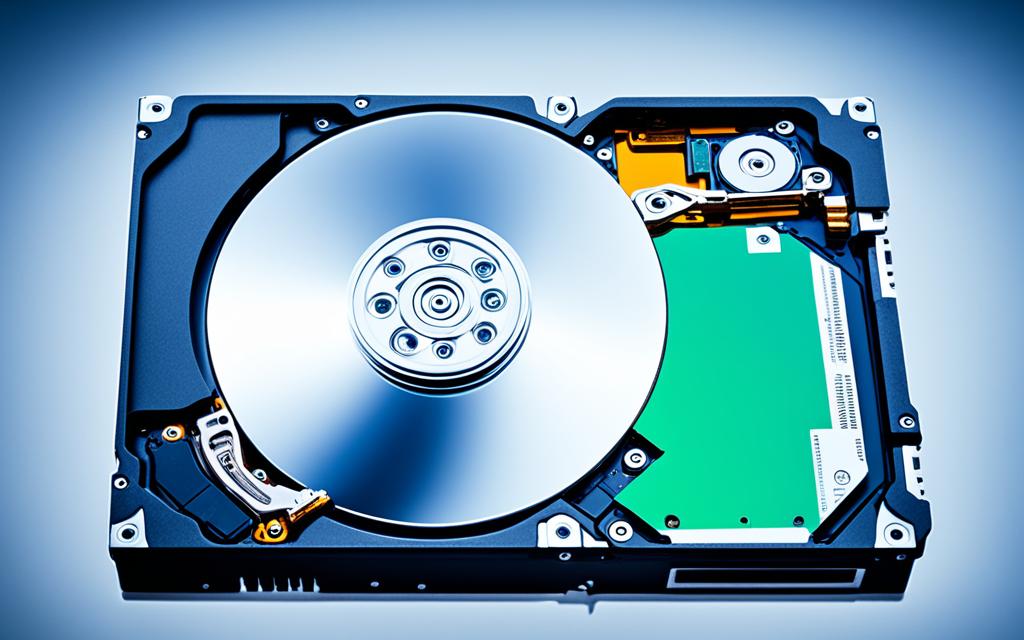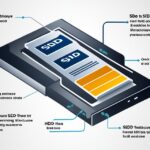Table of Contents
Deleting an operating system from a hard drive might seem tough, but it’s crucial for many when upgrading or needing more space. It’s more than just making room; it can make your computer run better and handle tasks more efficiently. The steps to remove an OS are important, from saving your data to making the changeover easy.
If you are moving to a new SSD or cleaning an old HDD, knowing how to remove an OS is key. Tools like the EaseUS Data Recovery Wizard are very helpful in keeping your files safe during this time. For more info on how to delete Windows, you can read this detailed article that shows you what to do1.
Key Takeaways
- Understand the reasons behind the need to delete an OS.
- Backup all essential data prior to starting the deletion process.
- Utilise reliable methods for deleting an OS, particularly for Windows and MacOS.
- Adopt tools like EaseUS Data Recovery Wizard to prevent accidental data loss.
- Consider the benefits of freeing up space and improving system efficiency.
- Ensure you’re ready with installation media for new operating systems post-deletion.
- Explore various options for managing your hard drive before proceeding with the deletion.
Understanding the Need for Deleting an OS
Many users think about deleting an OS for different important reasons. This could be because they want the latest version, to get rid of extra versions, or to fix performance problems. Knowing why you might delete an OS helps make your computer run better. Sometimes too little hard drive space affects how well your system works, making good management key for it to function best.
Why You Might Want to Delete an OS
People might delete an operating system for a few reasons. Maybe they want the new features and better security that come with a new OS. Too many OS versions can fill up your hard drive, making your computer slow and more likely to crash. Also, removing old or unused OS versions can make your system run more smoothly. This helps with organising your files and backing them up more easily.
The Benefits of Freeing Up Space
Deleting an OS has many advantages. It lets you use your disk space better, speeds up your computer, and makes it run more efficiently. When you get rid of an old Windows version after getting a new one, you can free up a lot of hard drive space. Consider moving files to the cloud to ease the load on your computer. Doing regular clean-ups by deleting can help manage hard drive space better, leading to fewer system lags and a nicer experience using your computer. For tips on how to free up more disk space, check out this useful guide: how to get more disk space on.
Preparing to Delete an Operating System
When you need to delete an operating system, being prepared is key. It’s all about keeping your data safe and making sure you have peace of mind. To do this well, you have to focus on two things: backing up your data and making a plan for recovery.
Backing Up Important Data
Backing up your data is crucial before deleting your OS. You’ve got to save all those important files, documents, and settings. There are a few ways to back up, including:
- Copying files to an external drive – This method offers a straightforward way to transfer files safely.
- Utilising cloud storage – Services such as Google Drive or Dropbox provide reliable options for secure backups.
A lot of users, about 63%, remove Windows from an SSD to make their computers run better. Half of these folks use a bootable USB to help with this2. Data recovery tools also play a part, making it easier to get back files if you need them.
Creating a Recovery Plan
It’s also vital to have a recovery plan when you’re deleting your OS. This plan should list the steps to get back your data if something goes wrong. With tools like EaseUS Data Recovery Wizard, you have a 99.7% chance of recovery1. Knowing you have a recovery plan can make you feel more secure.
In short, successful OS deletion relies on good data backup and a solid recovery plan.
How to Delete an OS from a Hard Drive
For Windows users, removing an operating system requires the right tools and knowledge. Knowing how to do it can prevent loss of data. Use Windows Disk Management to safely erase OS partitions.
Step-by-Step Guide for Windows Users
Start by opening the Windows Disk Management tool. It helps manage hard drive partitions. Here, you can see partitions and delete the OS you no longer need. Follow these steps:
- Right-click on the Start button and select Disk Management.
- Find the partition with the OS you want to get rid of.
- Right-click on that partition and choose Delete Volume to remove it.
It’s important to know which partitions you’re dealing with. Removing the OS partition deletes everything on it, so be careful. Always back up your data before starting to reduce risk3.
Using Disk Management
Make sure you’re deleting the right partition in Windows Disk Management. The OS partition looks different from others. Deleting it is easy but needs caution to avoid losing data. The least safe way to remove the OS is by manually deleting files. It’s better to use built-in tools4.
After deciding to delete, format the drive with another bootable device for the best results. This is key when removing Windows from the C partition4. It’s wise to consider professional advice on data loss prevention when deleting your OS. This helps keep your data safe.
Utilising Windows Installation Media for Deletion
Using Windows installation media is a trusted way to delete an OS via CD or USB. It lets users access important booting options. This ensures they can remove the existing operating system effectively. By booting from the media, individuals can clear their system. This makes space for a new installation or upgrade.
Booting from the Installation CD
First, insert the Windows installation CD or USB into the computer. Then, restart it. When the system is booting, go into the BIOS or UEFI settings. Here, change the boot order to prioritise the installation media. Once the system reads the media, a prompt will show. It leads users to start the deletion process.
Accessing the Installation Options
When on the Windows Setup screen, users need to pick their way through. Choose “Custom” to pick which partitions to delete. Before doing this, make sure you’ve backed up everything important. This step can’t be reversed and might erase data permanently. Following the guidance on the screen will fully remove the desired OS. It preps the computer for a new beginning. Using Windows installation media helps free up hard drive space. It boosts the system’s performance.
Safeguarding Your Data During Deletion
When deleting an operating system, it’s crucial to keep your data safe. This is key to protect private information and avoid losing data. Data recovery tools are very important in this process. They provide a backup if files get deleted by mistake. Tools like EaseUS Data Recovery Wizard are great for getting back lost files. They give users peace of mind when making system changes56.
Importance of Data Recovery Tools
Deleting a file or formatting a hard drive doesn’t fully erase data immediately; it just marks the space as free. Until new data overwrites the old, sensitive info could be exposed5. This shows the critical role of data recovery tools for protection. Also, using encryption can make your data even more secure against leaks6.
Using External Drives for Backups
Using external drives for backup is a smart way to keep your data safe. External hard drives offer lots of space and fast data transfer7. They’re useful for keeping important files, like bank details and personal photos, safe. Having data recovery tools and external backups means you can delete old systems without worry. Your important files stay safe.
FAQ
What are the common reasons for needing to delete an operating system?
People often delete an OS to upgrade to a new one. They may also do it to solve performance problems or to free up disk space. Removing an outdated OS can make your computer run better and faster.
How can I ensure my data is safe before deleting the OS?
Before deleting your OS, back up important files on external drives or cloud storage. Creating a recovery plan is also wise. It helps you retrieve lost data and gives you peace of mind.
What steps are involved in deleting an OS from a Windows hard drive?
To remove an OS, use the Disk Management tool in Windows. Choose the OS partition to delete and confirm your choice. It’s vital to know the difference between OS and data partitions to avoid losing important files.
Can I delete my operating system using installation media?
Yes, you can use Windows installation media like a CD or USB for deletion. Booting from it, you gain access to options for deleting the OS. This route is great for those wanting a clean install of a new OS.
Why is using data recovery tools important during the deletion process?
Tools like EaseUS Data Recovery Wizard act as a safety net for accidental data loss. They help recover lost files, keeping your valuable data safe during OS removal.
How can external drives assist in the deletion of an operating system?
External drives are great for backing up essential data before OS deletion. They keep your information safe and lower the risk of data loss.
Source Links
- https://www.easeus.com/questions/recovery/delete-os-from-hard-drive-but-keep-data.html – How to Delete the OS from a Hard Drive but Keep the Data
- https://www.diskpart.com/articles/how-to-delete-windows-from-ssd-0725.html – [Step-by-Step Guide] How to Delete Windows from SSD?
- https://satyeshukumar.medium.com/how-to-remove-windows-from-a-drive-but-keep-your-data-601a8688af09 – How to Remove Windows from a Drive but Keep Your Data
- https://datadestruction.com/how-to-wipe-a-hard-drive-without-deleting-windows/ – Learn How To Wipe A Hard Drive Without Deleting Windows
- https://dyrand.com/deleting-files-and-formatting-hard-drives-will-not-keep-your-data-secure/ – Data Security Beyond Deletion And Formatting – DyrandSystems
- https://www.cisa.gov/resources-tools/training/protecting-data-old-devices-you-dont-use-anymore – Protecting Data on Old Devices You Don’t Use Anymore | CISA
- https://consumer.ftc.gov/articles/how-remove-your-personal-information-you-get-rid-your-computer – How To Remove Your Personal Information Before You Get Rid of Your Computer








